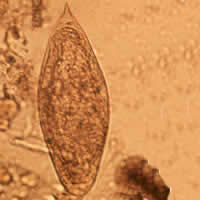Schistosoma intercalatum
| Schistosoma intercalatum | |
|---|---|
 |
|
| egg of Schistosoma intercalatum | |
| Scientific classification | |
| Kingdom: | Animalia |
| Phylum: | Platyhelminthes |
| Class: | Trematoda |
| Subclass: | Digenea |
| Order: | Stringeiformes |
| Genus: | Schistosoma |
| Species: | S. intercalatum |
| Binomial name | |
|
Schistosoma intercalatum Fisher, 1934 |
|
Schistosoma intercalatum is a parasitic worm found in parts of western and central Africa. There are two strains: the Lower Guinea strain and the Zaire strain. S. intercalatum is one of the major agents of the rectal form of schistosomiasis, also called bilharzia. It is a trematode, and being part of the Schistosoma genus, it is commonly referred to as a blood-fluke since the adult resides in blood vessels.
Humans are the definitive host and two species of freshwater snail make up the intermediate host, Bulinus forskalii for the Lower Guinea strain and Bulinus africanus for the Zaire strain.
The clinically defining characteristic of most schistosome species are their eggs' size and shape. The eggs of Schistosoma intercalatum have a terminal spine and tend to be moderately larger than those of S. haematobium (approximately 130 × 75 µm). The origin of the name 'intercalatum' is from the observation that their eggs are of an intermediate range between the smaller S. haematobium and larger S. bovis. These eggs are unique because they will stain red when exposed to the Ziehl-Neelsen technique, aiding in identification. When viewed using scanning electron microscopy, it can be observed that the S. intercalatum's surface has a much lower amount of integumental elevations, or bosses, than S. mansoni. This feature is consistent with the tegument appearance of other terminally spined schistosomes.
Schistosoma intercalatum's life cycle is very similar to that of S. haematobium, except for some key differences. To start the life cycle, the human host releases eggs with its feces. In water, the eggs hatch to become miracidia, which penetrate the freshwater snail intermediate host.S. intercalatum has two major strains, each with its own preferred bulinid host. The Zaire strain will use Bulinus africanus, while the Lower Guinea strain will use the extremely common B. forskalii as its intermediate host. The miracidia penetrate the snail tissue, and inside they become sporocysts and multiply. The sporocysts then mature into cercariae inside the snail host and are ready to leave. The cercariae are free-swimming in the surrounding water until they find their definitive host: a human. If there is a small temperature change, the cercariae of S. intercalatum will form concentrated aggregates near the surface of the water. This mechanism for body heat detection of a potential host restricts the formation of viable cercariae to small streams and slow moving bodies of water because of their high sensitivity.
...
Wikipedia
